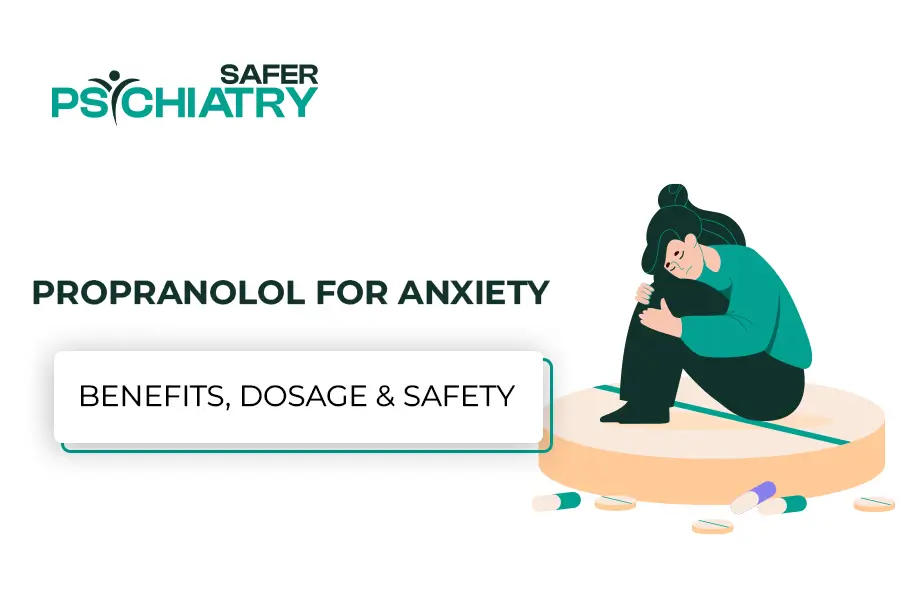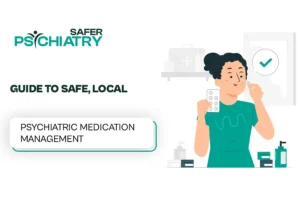
Propranolol for Anxiety - Benefits
Dosage & Safety
At Safer Psychiatry, we provide compassionate, evidence – based mental health care to support your well-being now and for the future – because your journey matters, and so do you.

- What is propranolol? Propranolol is a type of beta-blocker often prescribed for both certain heart conditions and to help manage the physical effects of anxiety.
- It can ease common anxiety-related body responses, such as rapid heartbeat, trembling, and sweaty palms.
- A typical propranolol dose for anxiety may range from 10 mg to 40 mg, taken before a known anxiety trigger.
- For best results, it’s generally taken about 30 to 60 minutes before the stressful situation.
- Possible side effects may include tiredness, lightheadedness, or a slower pulse rate.
- It’s important to get medical guidance before starting or changing your propranolol dosage.
What Is Propranolol for Anxiety?
Propranolol belongs to a type of medications known as beta-blockers. While its primary role is in cardiovascular care, it’s also widely used to help control the physical symptoms that can accompany anxiety.
While originally developed to treat high blood pressure, irregular heartbeat, and migraines, propranolol has become well known for its ability to manage the physical symptoms of anxiety.
Unlike antidepressants or anti-anxiety medications that directly affect mood, propranolol works by blocking adrenaline’s effects on the body. This can help prevent symptoms like trembling, sweating, and a rapid heartbeat in stressful situations.
How Does Propranolol Help Anxiety Symptoms?
Propranolol is particularly effective for situational anxiety ,moments when your body’s “fight or flight” response kicks in. This includes public speaking, job interviews, exams, or social events.
By reducing heart rate and calming physical tension, propranolol can make these situations feel less overwhelming.
However, it’s important to note that propranolol addresses physical symptoms, not the emotional or cognitive aspects of anxiety.
When to Take Propranolol for Anxiety
Timing matters when using propranolol for anxiety. For situational use, many providers recommend taking it about 30–60 minutes before the anxiety-inducing event. This permits sufficient time for the medication to proceeds effect.
Some patients may also use a daily dose, especially if they have frequent anxiety episodes, but this should only be done under close medical supervision.
Common Propranolol for Anxiety Dose Guidelines
Dosages may differ depending on the person’s health, the specific anxiety situation, and the prescribing clinician’s judgment.
- Common starting point: Around 20 mg of propranolol taken before a high-stress event.
- Usual range: 10–40 mg per dose, used on an as-needed basis.
- Maximum dose for anxiety: While doses above 40 mg are sometimes prescribed, this depends on the patient’s overall health and should only be adjusted by a healthcare provider.
Always follow your provider’s instructions, never adjust your propranolol dose for anxiety on your own.
How Quickly Does Propranolol Work for Anxiety?
Most patients notice the benefits within 30 to 60 minutes after taking propranolol. The relief from physical anxiety symptoms may last 3 to 6 hours, influenced by both dosage and individual metabolism.
Side Effects of Propranolol
Like any medication, propranolol may cause side effects. Common ones include:
- Fatigue or tiredness
- Dizziness or lightheadedness
- Slower than normal heart rate
- Cold hands or feet
While serious adverse effects are uncommon, they require urgent medical attention. Seek help immediately if you develop breathing difficulties, fainting spells, or swelling in your legs or feet.
Who Should Avoid Propranolol for Anxiety?
Propranolol isn’t suitable for everyone. You should avoid it or use it with caution if you have:
- Asthma or other serious breathing problems
- Certain heart rhythm disorders or heart failure
- Very low blood pressure
- Severe depression without treatment
Pregnant or breastfeeding patients should discuss safety with their healthcare provider.
Propranolol vs. Other Anxiety Medications
Compared to medications like benzodiazepines (e.g., Xanax medication) or SSRIs (e.g., sertraline), propranolol is non-sedating and not habit-forming.
It’s ideal for short-term or as-needed use but may not be as effective for chronic anxiety disorders.
Final Thoughts
Propranolol for anxiety can be an excellent option for people who experience intense physical symptoms in stressful situations. With the right dose and timing, it offers relief without the sedation or dependency risks of other medications.
As with any prescription drug, speak with a qualified healthcare provider before starting propranolol. Proper guidance ensures safe use and the best results.
FAQ
Frequently Asked Questions
What is propranolol & how organizes it work for anxiety?
Propranolol is a beta-blocker that reduces adrenaline’s effects, easing physical symptoms like rapid heartbeat and trembling.
How much propranolol should I take for anxiety?
Typical doses are 10–40 mg before a stressful event, but only your doctor can recommend the right dose for you.
Can I take propranolol daily for anxiety?
Some patients take it daily under medical supervision, but it’s more often prescribed for occasional use.
How fast does propranolol start working?
Most people notice effects within 30–60 minutes.
Is propranolol innocuous for long-term use in anxiety?
For many, yes but long-term use should be monitored closely by a healthcare provider.
Our Company
Copyright © 2024 Safer Psychiatric Consulting Services


